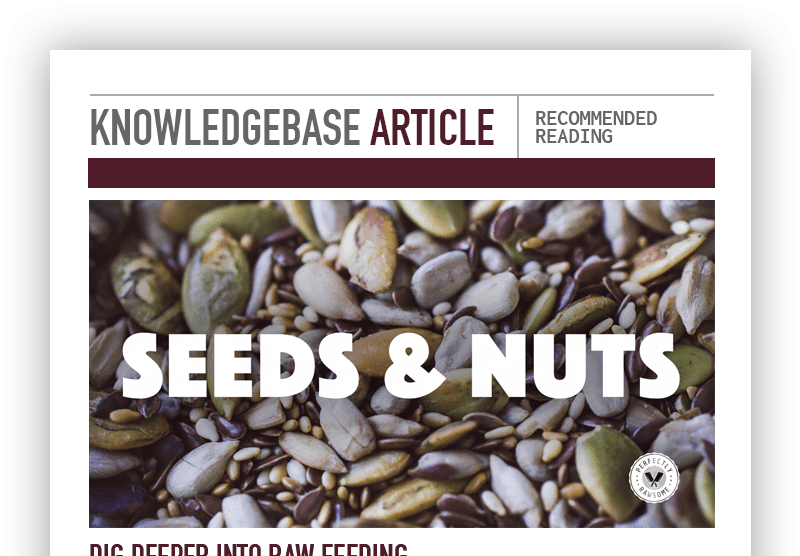Raw fat is often found in muscle meats and raw meaty bones within a raw diet. Although raw diets do not have a ratio guideline on how much fat the diet should include, it is important to ensure the diet provides sufficient amounts of fats. Including fat in the diet can be easily accomplished when strategically selecting ingredients to create a raw diet for a dog or cat.
Fat has a bad reputation and many marketing schemes have their way of demonizing fat while avoiding the important facts. Many pet parents are concerned with the potential for pancreatitis when feeding fat. It is important to know that feeding appropriate amounts of raw fat within a raw diet should not raise any risks for pancreatitis in a healthy dog. The difference lies within feeding raw fat and not cooked fat – cooked fat is a concern for pancreatitis and should be avoided.
Additionally, fat is often attributed to making pets overweight or even obese. However, fat does not cause obesity in pets – overfeeding and lack of physical activity are two main components in pet obesity.
Fat is a vital component to optimal health – it is essential for nutrient absorption, nutrient transportation, and is the ideal source of energy for carnivores such as dogs and cats.
Feeding Guidelines
Every animal is different and the amount of fat in a diet depends on individual needs.
Animal Fats
The primary source of fats should be sourced from animal fats.
Plant Fats
Some plant ingredients provide beneficial fats in addition to animal fats.
Puppies, dogs, and cats have essential fatty acid requirements needed for optimal health. Ensuring the raw diet has sufficient amounts of raw fat will help meet the minimum and recommended allowances for essential fatty acids, as well as provide a sufficient energy source to sustain daily activity and physiological functions
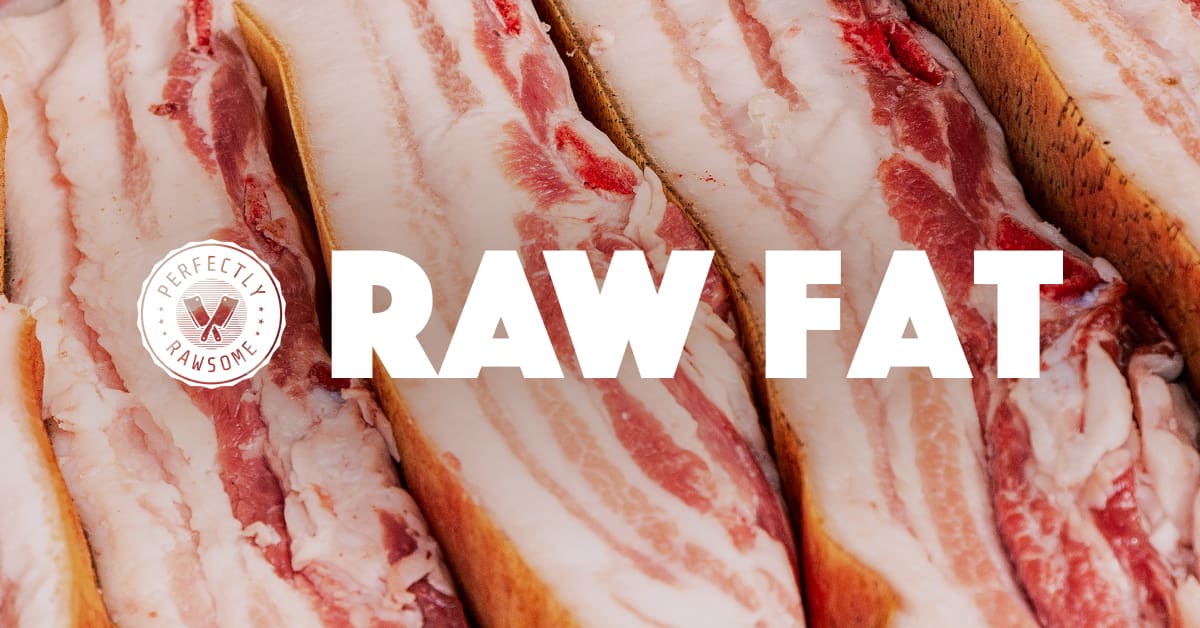
Feeding Guidelines
Boneless muscle meat and raw meaty bones (RMB) naturally provide raw fat depending on the protein option and ingredient selection. Some ingredients are very lean, with little to no fat, and others include higher amounts of fat.
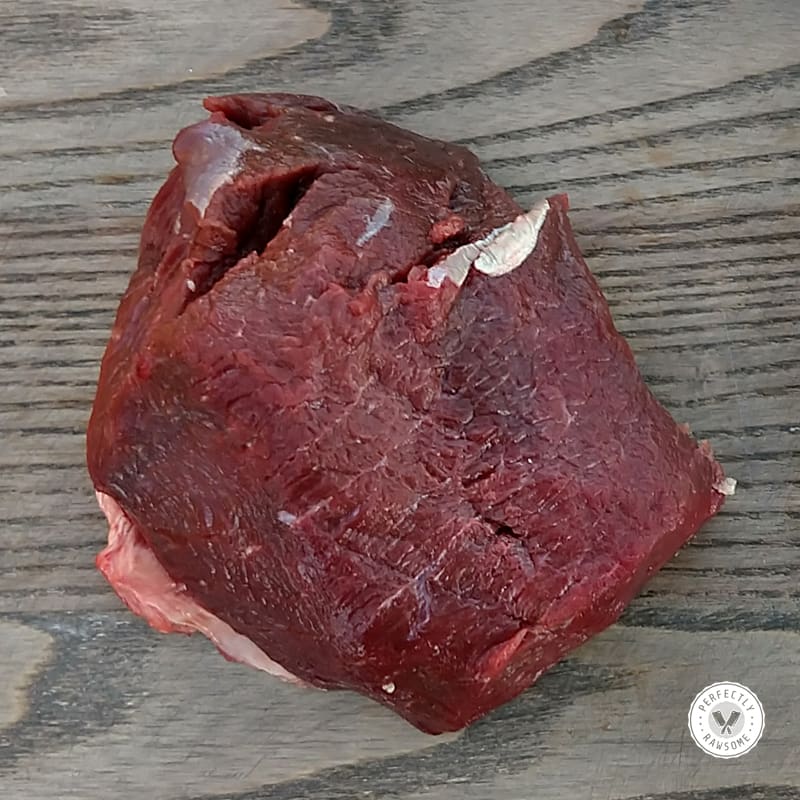
Lean Proteins
Below are examples of lean muscle meat proteins. There are many other options, these are just examples:
Chicken
Turkey
Quail
Rabbit
Wild Game
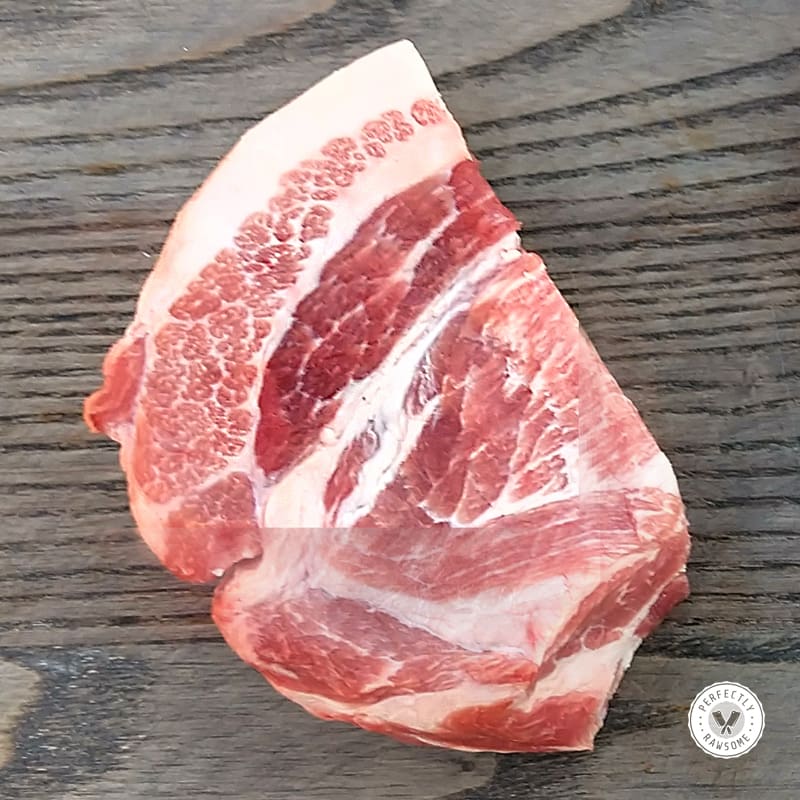
Fatty Proteins
Below are examples of fatty muscle meat proteins. There are many other options, these are just examples:
Duck
Goose
Pork
Lamb
Some Cuts of Beef
Raw diets that include ingredients with some visual amount of fat will provide sufficient amounts for the average pet with a moderate amount of activity. For the average pet, adding in more fats into the raw diet is not necessary if a balance between lean and fatty ingredients are included in the daily diet.
The Perfect Pairings
In general, it is ideal to pair a fatty raw meaty bone with a lean piece of muscle meat, or a lean raw meaty bone with a fatty piece of muscle meat. Pairing ingredients this way helps ensure there is sufficient amount of fats for moderate activity without having to add in additional fats.
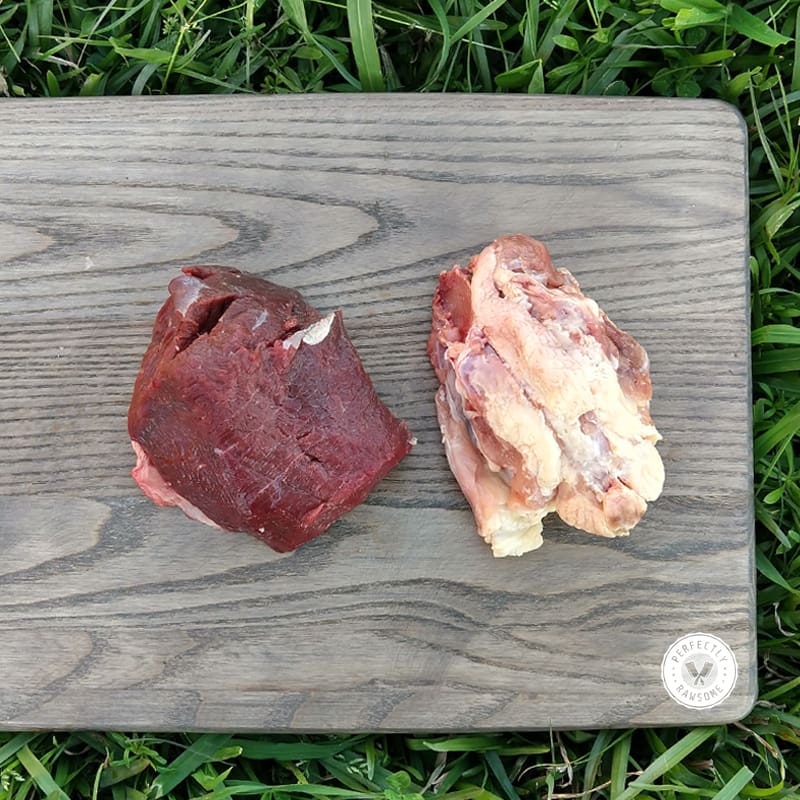
Fatty RMB + Lean Muscle Meat
Below are examples of pairing a fatty RMB with lean muscle meat. There are many other combinations, these are just examples:
Chicken Neck w/ Skin + Lean Pork
Pork Ribs + Skinless Chicken Breast
Chicken Back + Lean Beef 90/10
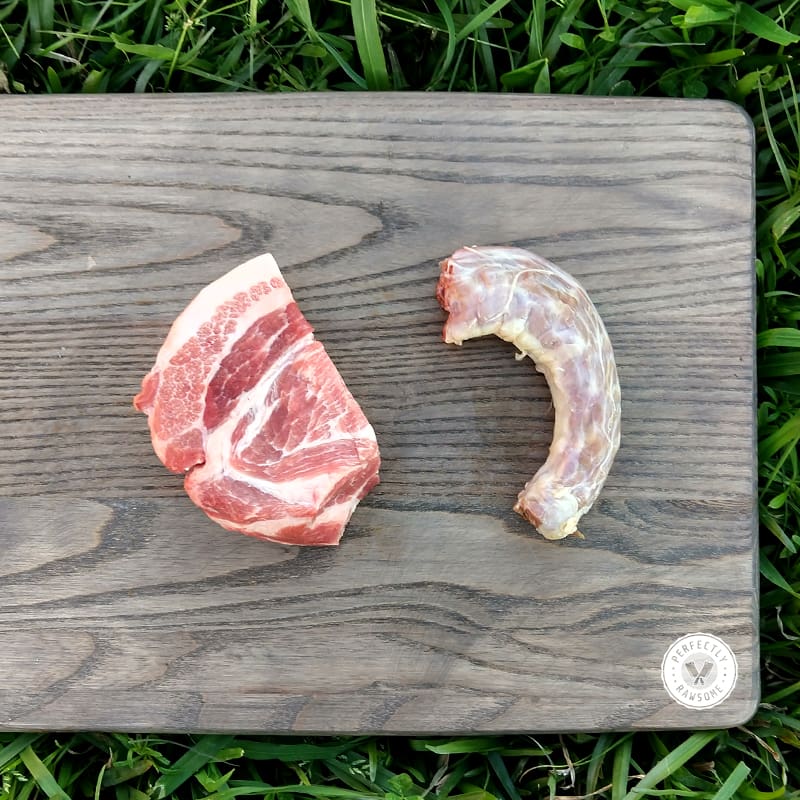
Lean RMB + Fatty Muscle Meat
Below are examples of pairing a lean RMB with fatty muscle meat. There are many other combinations, these are just examples:
Skinless Chicken Leg + Fatty Beef 80/20
Rabbit Leg + Fatty Pork
Skinless Turkey Neck + Lamb
Average, pet dogs typically receive a daily walk or run and additional playtime, but do not do any other high intensity activities. This guideline will provide sufficient amounts of fats for an average pet dog which works out to an average of 10% fat on an as fed basis.
Lean Meals Need Added Fat
A raw diet will lack essential fatty acids and a sufficient energy source if lean raw meaty bones and lean muscle meats are fed together. In these instances, it is important to add in additional fat sources to provide essential fatty acids and a sufficient energy source.
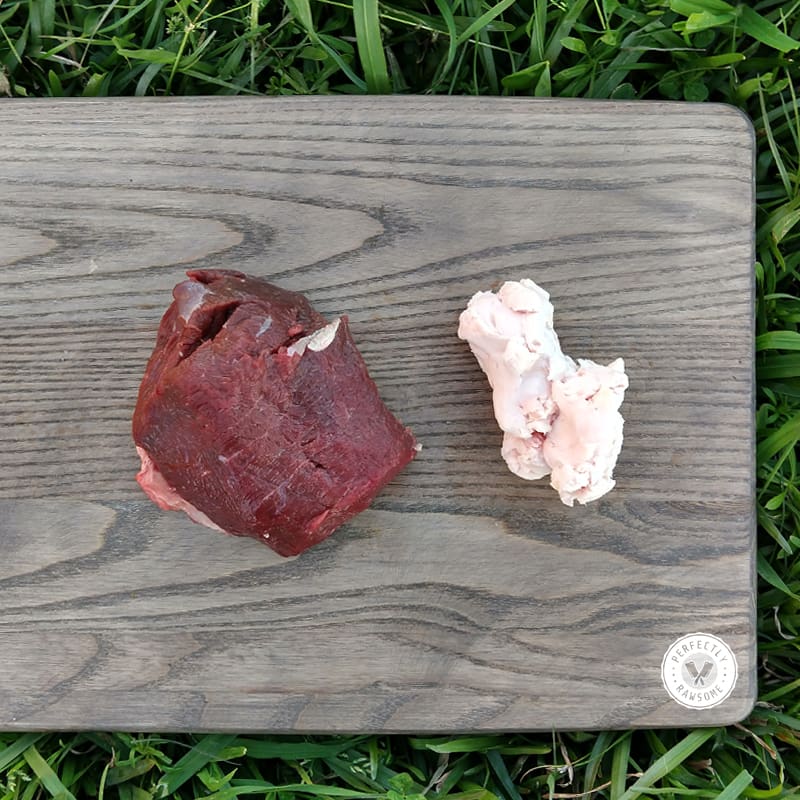
Animal Fat Addition
Below are examples of raw animal fats. All animals have raw fat in varying amounts, these are just examples:
Poultry Fat
Pork Fat
Ruminant Fat
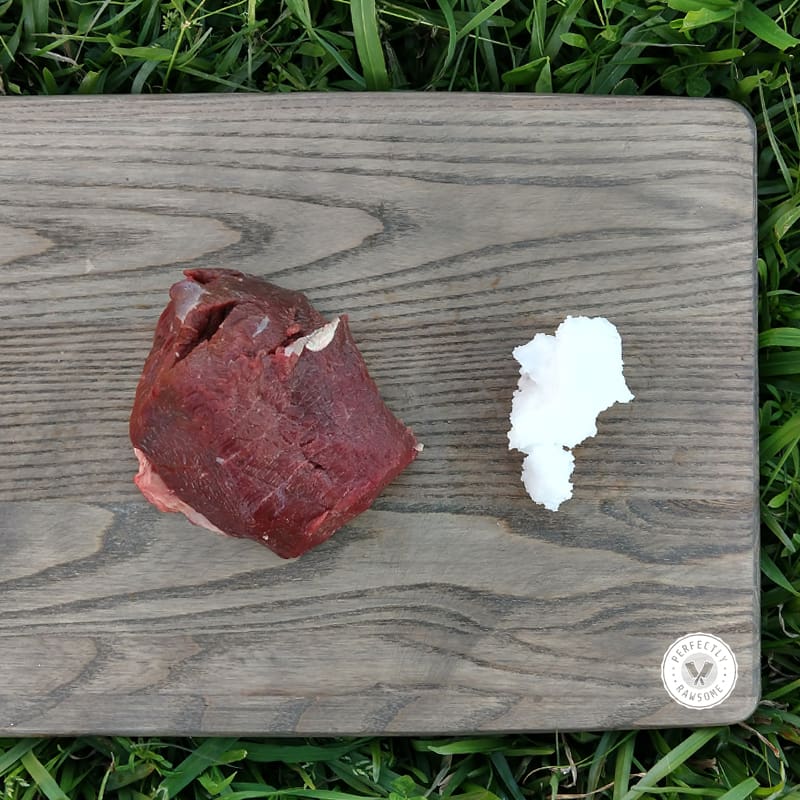
Plant Fat Addition
Below are examples of plant fats. There are only specific plant ingredients that have fat, these are examples:
Coconut Oil
Nuts
Seeds
The amount of additional fat added to the meal will depend on the amount of calories the dog requires. Fat is double the amount of calories in comparison to protein and carbohydrates. Therefore, a little goes a long way! Using 5% of the overall diet is a good guideline to start with when adding in additional fat to lean meals.
High Fat Meals for Active/Working Dogs
Highly active dogs will require more calories from fat to sustain long-term activity without fatigue. These dogs typically receive more than 3 hours of medium to high intensity exercise a day, in which the dog benefits from a raw diet higher in fat than what is generally recommended for the average pet dog.
In these instances, using lean RMBs and lean muscle meat is ideal to ensure essential amino acids are met for healthy muscle function, but the diet will be lacking in fat as an energy source. Therefore, adding in additional fats is necessary, but the amount of added fat will exceed the recommendations for an average pet dog.
It is recommended to add 5% fat to the raw diet if lean RMBs and lean muscle meats are fed to an average pet. This amount doubles for highly active and working dogs, sometimes triples, which feeding a ketogenic-like diet is recommended.
A ketogenic raw diet is often associated with cancer, but the diet also has its place for highly active and working dogs as well! However, the difference between the raw ketogenic diet for active dogs is that it follows a 1:1 fat to protein ratio which is higher in protein in comparison to the keto diet for cancer. This means the diet will provide 1 gram of fat to every 1 gram of protein.
Ketogenic Calculations
Feeding a ketogenic diet to a highly active and working dog requires calculations to ensure all essential amino acids are fed on a daily basis to ensure healthy muscle function.
Animal Fats
The primary source of fat should come from animal sources. These fats are the ideal sources of essential fatty acids for carnivores. Animal fats are commonly found in muscle meats and raw meaty bones, but can be provided through raw fat trimmings.
Poultry Skin & Fat
Chicken, turkey, duck, and goose skin and fat are similar in the types of essential fatty acids they provide. Poultry skin and fat are high in essential linoleic acid (LA) which is a polyunsaturated fat (PUFA). Raw meaty bones from poultry such as necks, backs, and feet that include the skin and fat will provide LA fatty acids in the raw diet.
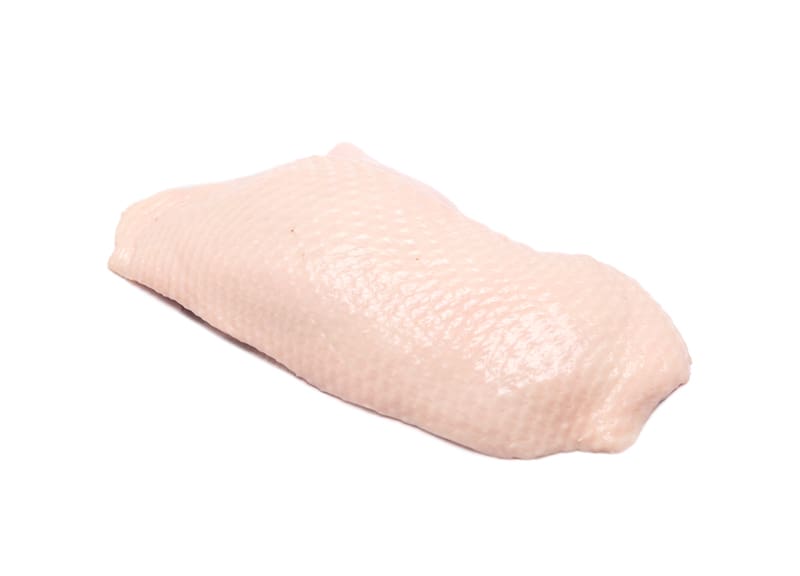
Raw Chicken Fat Nutritional Data
Macronutrients
The amount of calories, protein, fat, and carbs are based on 1oz (28g).
| Moisture | 28.9% |
| Protein | 3.7% |
| Fat | 67.9% |
| Carbohydrate | 0% |
Fat Breakdown
The amount of in 1oz (28g) of raw chicken fat.
| Saturated Fat | 5.66 g |
| Monounsaturated Fat | 8.48 g |
| Polyunsaturated Fat | 3.98 g |
Pork Fat
Pork fat is very similar to poultry skin and fat in reference to the types of fatty acids it provides. Pork’s unique ability to be a source of vitamin D is what makes it a bit different than other fat sources. Pasture raised pork that has access to green pastures and sunlight will have a high vitamin D content within the fat!
Raw pork muscle meat with the fat attached and pork raw meaty bones such as pork tails and ribs will provide LA fatty acids in the raw diet. However, the pork must be pasture raised for human consumption in order to gain the benefits of the vitamin D within the fats.

Raw Pork Fat Nutritional Data
Macronutrients
The amount of calories, protein, fat, and carbs are based on 1oz (28g).
| Moisture | 7.9% |
| Protein | 2.9% |
| Fat | 88.6% |
| Carbohydrate | 0% |
Fat Breakdown
The amount of in 1oz (28g) of raw pork fat.
| Saturated Fat | 9.02 g |
| Monounsaturated Fat | 11.76 g |
| Polyunsaturated Fat | 2.91 g |
Ruminant Fat
Beef, lamb, goat, and wild game such as venison and elk have similar fatty acid profiles within the raw fat. These proteins have lower LA fatty acids and higher alpha-linolenic acid (ALA) which is also a PUFA. Boneless muscle meat with the fat attached will provide some LA and ALA fatty acids within the diet.

Raw Beef Fat Nutritional Data
Macronutrients
The amount of calories, protein, fat, and carbs are based on 1oz (28g).
| Moisture | 20.2% |
| Protein | 8.2% |
| Fat | 70.9% |
| Carbohydrate | 0% |
Fat Breakdown
The amount of in 1oz (28g) of raw beef fat.
| Saturated Fat | 8.23 g |
| Monounsaturated Fat | 8.65 g |
| Polyunsaturated Fat | 0.72 g |
Adjust To Individual Needs
Some pets can tolerate all types of animal fats while others are sensitive to specific animal fats. It is important to adjust to the pet’s individual needs if specific animal fats are not tolerated.
Plant Fats
In addition to animal fats, plant fats provide essential nutrients to a raw diet. Plant fats are generally monounsaturated fats (MUFAs) and polyunsaturated fats (PUFAs). These fats should come secondary to feeding animal based fats.
Coconut Oil
There are not many plant ingredients that are high in saturated fat like coconut oil. However, coconut oil is unique in its comparison to other saturated fats because it is a Medium Chain Triglyceride (MCT).
Coconut oil supplies some LA fatty acids, but is mostly a source of saturated fat for energy. Many pets who cannot tolerate high animal fats can consume coconut oil without any ill effects. In these instances, it serves as the ideal fat source for pet’s with sensitivities to animal fats.

Coconut Oil Nutritional Data
Macronutrients
The amount of calories, protein, fat, and carbs are based on 1oz (28g).
| Moisture | 0.03% |
| Protein | 0% |
| Fat | 99.06% |
| Carbohydrate | 0% |
Fat Breakdown
The amount of in 1oz (28g) of coconut oil.
| Saturated Fat | 23.1 g |
| Monounsaturated Fat | 1.8 g |
| Polyunsaturated Fat | 0.48 g |
Raw Seeds & Nuts
The addition of raw seeds and nuts such as hemp seeds, almonds, and others are fed because they provide beneficial essential nutrients. Additionally, raw nuts and seeds are a plant source of fats. However, it is important to keep these ingredients to a minimum within a BARF model diet and be sure to prepare them for optimal digestion.
Seeds, such as hemp seeds, are beneficial in their use to balance out the fatty acids (LA:ALA) within a raw diet. Other seeds that provide this benefit are flax and chia seeds. While seeds and nuts such as almonds and sunflower seeds do not provide much benefit for fatty acid balance, they do have beneficial nutrients in addition to the healthy fats they provide.

Sunflower Seed Nutritional Data
Macronutrients
The amount of calories, protein, fat, and carbs are based on 1oz (28g).
| Moisture | 4.9% |
| Protein | 31.5% |
| Fat | 48.7% |
| Carbohydrate | 8.6% |
Fat Breakdown
The amount of in 1oz (28g) of hemp seeds.
| Saturated Fat | 1.31 g |
| Monounsaturated Fat | 1.5 g |
| Polyunsaturated Fat | 10.8 g |

Almond Nutritional Data
Macronutrients
The amount of calories, protein, fat, and carbs are based on 1oz (28g).
| Moisture | 4.4% |
| Protein | 21.1% |
| Fat | 49.9% |
| Carbohydrate | 21.5% |
Fat Breakdown
The amount of in 1oz (28g) of almonds.
| Saturated Fat | 1.08 g |
| Monounsaturated Fat | 9.01 g |
| Polyunsaturated Fat | 3.5 g |
Feeding Raw Seeds & Nuts
Learn more about feeding seeds and nuts in a raw diet for dogs. These ingredients provide a wide range of essential fatty acids, vitamins, and minerals.
Plant Oils
Raw seeds and nuts require additional preparation to ensure optimal digestion which can become time consuming. The use of the plant oils can serve as an alternative. Example: hempseed oil can be fed instead of hemp seeds for the same fat benefits.
CLOSING COMMENTS
All dogs and cats have a requirement for fat which supplies an ideal source of energy for daily activity and it serves a vital role in nutrient absorption and nutrient transportation. Feeding guidelines for raw fat in a raw diet will vary on the pet’s daily activity, but on average it is recommended to pair fatty RMBs with lean muscle meat or lean RMBs with fatty muscle meat for average pets. However, additional animal fats are needed if lean RMBs and muscle meats are fed.

